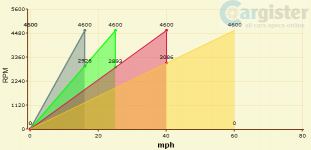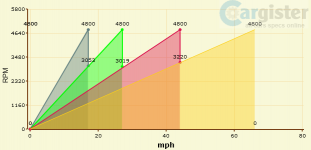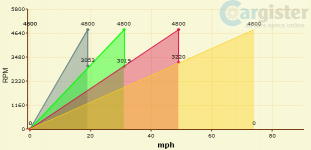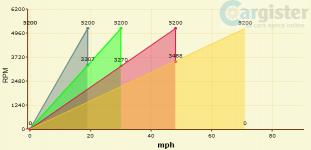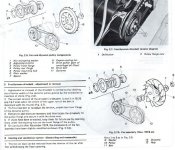I noticed a useful lengthening of the gears when fitting the gearbox from a 126 and this uses the additional power of the bigger engine whilst keeping the high rpm reasonable at speed. Putting aside the fact that an everyday engine may not work well with the BIS crownwheel and pinion, does anyone know if the difference it makes to comfortable top cruising speed is in the same order of magnitude as going from the 500 to the air-cooled 126 setup.... someone was asking me. 
You are using an out of date browser. It may not display this or other websites correctly.
You should upgrade or use an alternative browser.
You should upgrade or use an alternative browser.
Technical Top speed increase with 126 BIS pinion.
- Thread starter fiat500
- Start date
Currently reading:
Technical Top speed increase with 126 BIS pinion.
I've dug up my own answers and welcome anyone to refute them. I've worked it out from a basic online tool which doesn't take anything into account other than the basic gear ratios and the RPM of maximum engine power and I'm assuming standard tyres so a diameter of approx. 500mm.
It seems to accurately reflect experience on a standard 500 setup giving a top speed at 4600 rpm of 60mph. (1)
On a standard 650 engine at 4800 you get about 63mph. (2)
On a standard 650 engine at 4800 with a BIS crownwheel/pinion you get about 73. (3)
Taking into account that I can easily achieve a speedo reading of 70mph+ with a standard 650 and gearbox this implies an engine speed of 5200rpm! (4)
(4)
Stick the BIS setup in the diff at the same rpm and you get a theoretical 80mph. (5)
As I said initially, I'm not debating either the realistic chance of achieving this nor the advisability of doing it; I am aware that other aspects of performance would be likely to suffer and the whole essence of the 500's fun driving experience would probably disappear. But for straight-line cruising, of which I do quite a lot, it might make driving a Fiat 500 much quieter or quicker.
It seems to accurately reflect experience on a standard 500 setup giving a top speed at 4600 rpm of 60mph. (1)
On a standard 650 engine at 4800 you get about 63mph. (2)
On a standard 650 engine at 4800 with a BIS crownwheel/pinion you get about 73. (3)
Taking into account that I can easily achieve a speedo reading of 70mph+ with a standard 650 and gearbox this implies an engine speed of 5200rpm!
Stick the BIS setup in the diff at the same rpm and you get a theoretical 80mph. (5)
As I said initially, I'm not debating either the realistic chance of achieving this nor the advisability of doing it; I am aware that other aspects of performance would be likely to suffer and the whole essence of the 500's fun driving experience would probably disappear. But for straight-line cruising, of which I do quite a lot, it might make driving a Fiat 500 much quieter or quicker.
Attachments
Last edited:
I noticed a useful lengthening of the gears when fitting the gearbox from a 126 and this uses the additional power of the bigger engine whilst keeping the high rpm reasonable at speed. Putting aside the fact that an everyday engine may not work well with the BIS crownwheel and pinion, does anyone know if the difference it makes to comfortable top cruising speed is in the same order of magnitude as going from the 500 to the air-cooled 126 setup.... someone was asking me.
Hi Peter, If you put together a list of later 126 engine output figures you get the following -
595 engine 23bhp / 17.1511kW
652 engine 24bhp / 17.7kW
BIS engine 24.8bhp / 18.5kW
Panda 30 30bhp / 22.371kW
so the jumps between the stages are not great for standard engines. Unfortunately I cannot comment about a standard comparison as my engine has 30+ bhp.
The difference in overall performance will depend on the tyre size, and the gearbox ratio's fitted from the standard.
To give you an idea of the differing speeds between the 8/39 and 9/39 differential with the 126 gearbox you can look at the following site (this is not exact but close enough) look at the 'westfield-world kit car support site' at the top of the page go to 'tools' and select 'gearbox ratio calculator' from the dropdown. Input tyres, diff ratio, gear ratio, and the format of display mph/kph. The diff ratio for the 8/39 is
4.875 and the diff ratio for the 9/39 is 4.333
see what you get. I have to say that after fitting the 9/39 diff my speedo underreads slightly, and the car cruises at a much more comfortable rev point 50mph is achieved at just under 3500rpm - I think
if you need any more info get back to me.
Ian.
So the logical next question that perhaps Ian Bleeding Knuckles can answer is how would a car with that stretched final-drive handle a very steep gradient such as the 20% hills that I'm familiar with.
Bigvtwin996
Established member
- Joined
- Jul 19, 2011
- Messages
- 1,348
- Points
- 430
So the logical next question that perhaps Ian @Bleeding Knuckles can answer is how would a car with that stretched final-drive handle a very steep gradient such as the 20% hills that I'm familiar with.
But also what effect would this have on cooling...?
clearly with a higher diff you would have lower revs..
So to "Drive the car like you stole it" (as a member suggested) to maintain cooling would mean keeping the car in lower gears to maintain revs...
The obvious side effects would be increased fuel consumption and increased engine and gearbox wear...
But also what effect would this have on cooling...?
clearly with a higher diff you would have lower revs..
So to "Drive the car like you stole it" (as a member suggested) to maintain cooling would mean keeping the car in lower gears to maintain revs....
Good and serious point.
So the logical next question that perhaps Ian Bleeding Knuckles can answer is how would a car with that stretched final-drive handle a very steep gradient such as the 20% hills that I'm familiar with.
So the logical next question that perhaps Ian Bleeding Knuckles can answer is how would a car with that stretched final-drive handle a very steep gradient such as the 20% hills that I'm familiar with.
Hi Peter, I'm afraid that without the same geography as you I cannot accurately compare, but on the shortish hills we have around the dales the car manages well, but again it is not standard and allowing for that I still have to change down two gears if required on the very steep bits. To be honest a modern car would have to do the same to some extent. I've been doing a little research and although the tables don't cover the small 500/126 tyres it's still possible to get a idea of things.
if we establish that the 126 tyre (135x12) has an overall diameter of 493.94 and the BIS tyre (135x13) has an overall diameter of 519.3 we can be in the ballpark using my tyre size (165x60-12) which has a diameter of 502.94. with me so far????
SO, The last 500 had some 23bhp @ 4800rpm with the 8/39 diff that equates to around 65mph, the weight being moved was 530kg. The 126 (652cc) had some 24bhp @ 4500rpm with the 8/39 diff this equates to around 63mph, the weight being moved was 600kg. If we believe that the BIS engine was heavier (water cooled) we only have 24.8bhp @ 4500rpm with the 9/39 diff this equates to 70mph.
So you have a car that is at least 70kg lighter with only 0.8bhp less (ish) driving at 7mph more
The engine is always going to get hot on a climb - lack of speed and cooling. remember the Panda 30 was a much bigger/heavier car with the same air cooled twin pot.
The only thing to do is try it ?????
Ian.
That all makes sense Ian... I must tell the person who was asking me. 
Good and serious point.There have to be reasons why Fiat stuck at the 5.25:1 ratio and that may be one of them. The BIS was water-cooled and mine got very hot.
A point made by johnny500 in his description of his recent engine rebuild seemed to slip under the radar. He mentioned that he was getting an increased air flow from the alloy fan that he fitted therefore you have to assume improved cooling. Useful to know as the alloy fans are not too expensive.
When building the gearbox to go with the tuned engine in my 126 I decided not to fit the Bis diff I had and was happy with my instincts. Most of my driving would be in busy built up areas and acceleration was more important than the ability to hit 80mph.
Last edited:
My question is now thoroughly answered. I've taken from this that it would be worth a punt if you had time money and gearboxes to spare. My "friend" has some of the above and is a serial mod-der, so I'll report back if anything happens. 
A point made by johnny500 in his description of his recent engine rebuild seemed to slip under the radar. He mentioned that he was getting an increased air flow from the alloy fan that he fitted therefore you have to assume improved cooling. Useful to know as the alloy fans are not too expensive.
Now well off subject...but it's my subject.
I've never fancied the alloy impellers because on the images of them they look a bit crude and possibly imbalanced.
Just recently noticed that the Haynes 126 manual (not a "Bible" by any means, I know) mentions a different "fan" on later models; probably just an error but they even look to have blades going in opposite directions.
Attachments
My question is now thoroughly answered. I've taken from this that it would be worth a punt if you had time money and gearboxes to spare. My "friend" has some of the above and is a serial mod-der, so I'll report back if anything happens.
The serial mod-der is obviously me and on new year, day one, I've fitted the rebuilt box with the aforementioned differential.
I haven't had the chance to thoroughly test it but first impression over a couple of miles is .........what's the fuss about? The main difference is that the speedo is reading a bit pessimistic on mph and therefore also on miles covered, so arithmetical adjustments will be needed there. The car certainly doesn't feel as if performance is dulled. As hoped for, the gearbox is a bit quieter but not as much as I expected. I really should have replaced first gear as it is almost comically noisy now...maybe hard to live with unless it settles down.
Tomorrow we'll get on the open road and put it through its paces [emoji3]
Last edited:
The serial mod-der is obviously me and on new year, day one, I've fitted the rebuilt box with the aforementioned differential.
I haven't had the chance to thoroughly test it but first impression over a couple of miles is .........what's the fuss about? The main difference is that the speedo is reading a bit pessimistic on mph and therefore also on miles covered, so arithmetical adjustments will be needed there. The car certainly doesn't feel as if performance is dulled. As hoped for, the gearbox is a bit quieter but not as much as I expected. I really should have replaced first gear as it is almost comically noisy now...maybe hard to live with unless it settles down.
Tomorrow we'll get on the open road and put it through its paces [emoji3]
There you go Peter the proof is in the eating - or driving so to speak. The overall gear ratio steps that Fiat have used have been set for good reason, but I would dearly love to know what the gear and diff ratios are for the Panda 30 (Anybody???) given that the engine used produced it's top output at 5500rpm. Regarding hot running, I believe that if one does all one can to effectively seal every gap in the fan housing so that the maximum air flow is maintained over the engine fins a standard engine should not suffer. Every modified engine of above 30bhp available to buy is run with an oil cooler for good reason and likewise my motor is too.
Ian.
Update:
Today we did about 75 miles of which around sixty of them were on the Highlands' only dual carriageway and fast "A"-road. I recorded a best actual speed of 65.5mph and there was power left to take it faster. The overall feel is of a car which is much more comfortable than before at the true speed of 60mph which I have become used to with the 650 engine. On more minor roads with natural bends and gentle gradients it's a bit more like when the car had its original engine. This means that there's more gear-changing than before. In town it's brilliant because third gear is very flexible and at the limit of 30mph it never feels to be over-revving as it used to. Gear changes are perfectly spaced at almost the same marked points on the speedo as before; the difference being that I'm actual going a few miles faster than indicated at each gear-change.
There is a very long and relatively steady incline on a main road which had become my Nemesis with a 499 engine. This was easily overcome when I changed to the 652 engine but the new final-drive ratio did cause the car to struggle little in top gear, but if I had dropped down a gear the engine speed might have been a little high. I suspect that the gearing will be ideal for those plodding hills when you daren't change out of second but the engine is revving a bit too high. :bang:
There was no sign of overheating whatsoever, with the thermostat flap almost closed on the several occasions when I checked it; but bear in mind that it was 5C outside.
There is a side issue which has come about now that I have definitely eliminated the screaming noise that used to come from the differential; I can now hear the deeper noises from the engine, some rattles from the bodywork that never existed before and the wind noise (external) .
.
But my overall conclusion is that if you have a 650 in good condition and like to eat miles, this is a good modification. It would definitely not work for a 499 engine and would be no good if you like to pootle about or impress or startle other road-users with your acceleration.
I was able to obtain the crownwheel and pinion brand-new off eBay direct from an Italian manufacturer. the difference in price between this and a standard set was marginal.
Today we did about 75 miles of which around sixty of them were on the Highlands' only dual carriageway and fast "A"-road. I recorded a best actual speed of 65.5mph and there was power left to take it faster. The overall feel is of a car which is much more comfortable than before at the true speed of 60mph which I have become used to with the 650 engine. On more minor roads with natural bends and gentle gradients it's a bit more like when the car had its original engine. This means that there's more gear-changing than before. In town it's brilliant because third gear is very flexible and at the limit of 30mph it never feels to be over-revving as it used to. Gear changes are perfectly spaced at almost the same marked points on the speedo as before; the difference being that I'm actual going a few miles faster than indicated at each gear-change.
There is a very long and relatively steady incline on a main road which had become my Nemesis with a 499 engine. This was easily overcome when I changed to the 652 engine but the new final-drive ratio did cause the car to struggle little in top gear, but if I had dropped down a gear the engine speed might have been a little high. I suspect that the gearing will be ideal for those plodding hills when you daren't change out of second but the engine is revving a bit too high. :bang:
There was no sign of overheating whatsoever, with the thermostat flap almost closed on the several occasions when I checked it; but bear in mind that it was 5C outside.
There is a side issue which has come about now that I have definitely eliminated the screaming noise that used to come from the differential; I can now hear the deeper noises from the engine, some rattles from the bodywork that never existed before and the wind noise (external)
But my overall conclusion is that if you have a 650 in good condition and like to eat miles, this is a good modification. It would definitely not work for a 499 engine and would be no good if you like to pootle about or impress or startle other road-users with your acceleration.
I was able to obtain the crownwheel and pinion brand-new off eBay direct from an Italian manufacturer. the difference in price between this and a standard set was marginal.
Last edited:
Similar threads
- Replies
- 4
- Views
- 513


